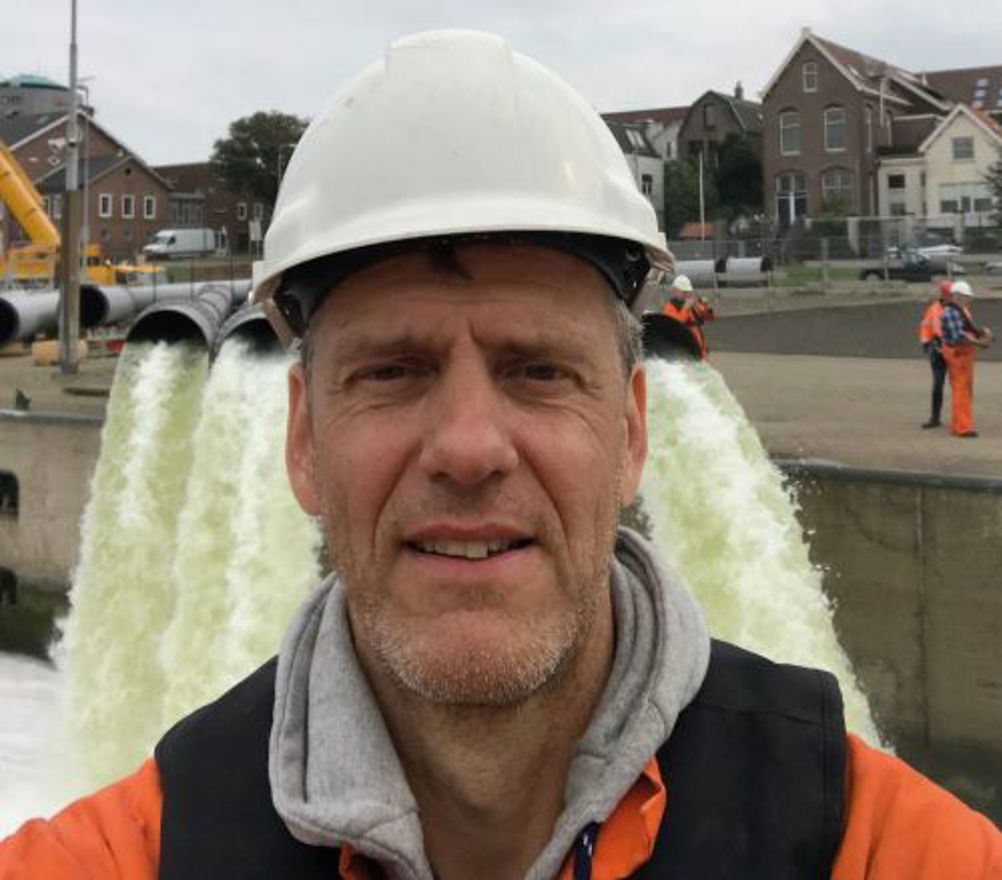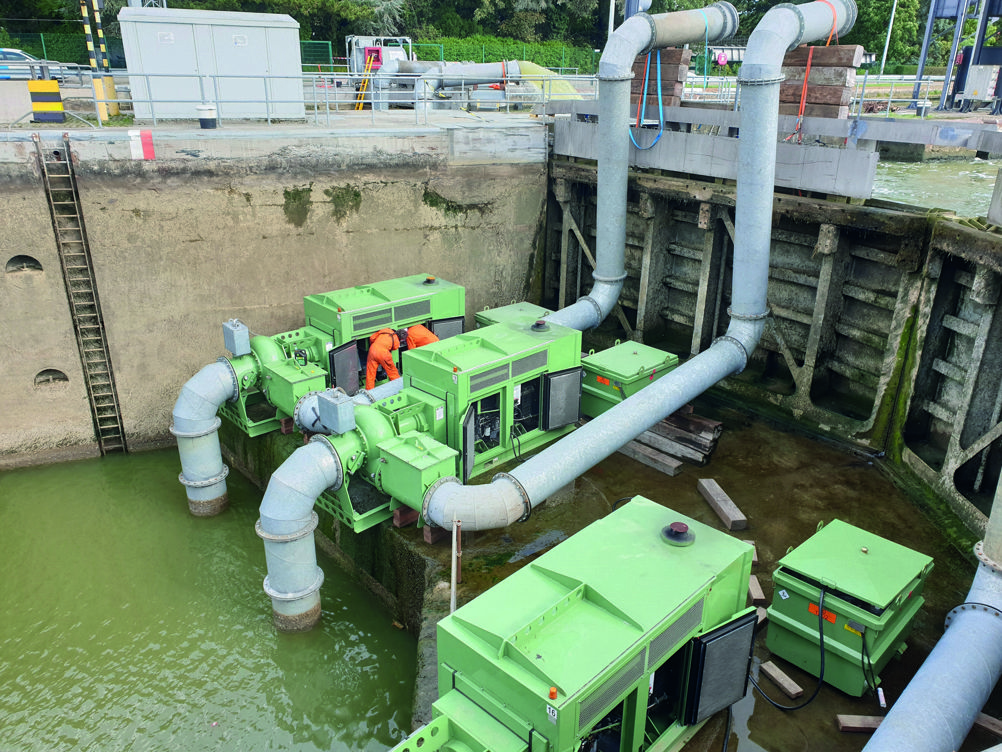When a storm surge caused the North Sea to flood a big chunk of the Netherlands in 1953, the government had to import pumps from America to get the water out again. This drove home that they needed to be prepared. “So they had mobile pumps made: 25 for the central government and 50 for the waterboards,” says Dick Verbaan, technical advisor on locks and movable bridges at Rijkswaterstaat (the executive agency of the Dutch Ministry of Infrastructure and Water Management). One day a week he does planning, maintenance, improvement and deployment of the Dutch mobile emergency pumps.
He explains that in 2000 they put out a tender for new pumps, quite a challenge: “These pumps have to be deployable anywhere. Weight versus flow rate was key, but pump diagrams usually only show pressure versus flow rate. A 10.000 m3/h pump will easily weigh 15 tons: you can’t put that onto a burst, soggy dike, not to mention the heavy mobile cranes you’d need. We required ten 3000 m3/h pumps weighing 3,5 tons each, and ten 5000 m3/h pumps weighing 5 tons. Initially, the 5000 m3/h pumps turned out to be 500 kilos overweight. So holes had to be drilled and steel replaced with plastic, for example for the doors. In 2005, the first ten pumps were delivered by Pasman, and in 2008 another ten by BBA. If we deploy all twenty, we can pump about 22 m3/s. So we can replace an average pumping station.”

Size matters
Size was important as well since the pumps have to be transportable by trucks and aircraft. The larger pumps are 5 meters long and 2.10 meters wide. The pumps form units with their engines, but without internal diesel tanks. “And we opted for belt drives to cater for torsion in the setups,” Verbaan adds. “The 3000 m3/h has a John Deere six-cylinder with 142 kW at 1800 rpm, the 5000 m3/h a Deutz with 174 kW at 2100 rpm engine. They all have 600 mm outlets. The inlets are 600 mm on the 3000s and 700 mm on the 5000s.”
Diesel power was chosen because it’s more mobile and available everywhere. “Otherwise we’d have to mess with generators and frequency convertors. And the diesels are supported all over the world, so parts and mechanics can always be sourced locally.”
The pumping unit can be on location anywhere in the Netherlands within 12 hours, and abroad within three days. “We typically are much faster. If I give the call, the trucks are here within an hour and we put the pumps, pipes, check valves and tool container onto low-loaders. When we were at the New Orleans flood in 2005, we saw an American crew set up a massive pump with giant cranes: took them more than a week. We had two pumps up and running in 24 hours.”
Excesses, shortages and destruction
Since 2000, Verbaan and his team have been on 12 missions, of which five were abroad. For example they were in the province of Zeeland when a pumping station couldn’t cope with sustained, heavy rain.
Torrential downpours were also the cause of a flood in the town of Kockengen in 2014. In 2020 and 2021 they were in IJmuiden to replace a defective 60 m3/s pumping station maintaining the level of the North Sea Canal. “If that rises too much, Amsterdam would get into trouble. But in recent years, we increasingly have to go out to water shortages. Last year for example we were at a defective pumping station near Utrecht. Water had to be brought in because the salinity got too high. We pumped in 5 million m3 with four pumps. Before that, we were at the Afsluitdijk, when the level of the IJsselmeer sank and the salinity near drinking water intakes became too high.”
They mostly operate in Europe. “Europe has a civil protection mechanism where every country can submit disaster relief modules. If countries need help, Brussels can coordinate the modules. Besides our EU certified pumping team, the Netherlands for example has the Urban Search and Rescue team.”
More European countries are standing by with pumping units, but not with the Dutch capabilities. “Other countries are more focused on crises common to them. They have high-capacity pumping units to deal with fires and such. Our pumping unit is focused on extreme flow rate, not high pressure.”
They’ve also been to Poland. “And New Orleans was gigantic with hovercrafts, helicopters, Antonov aircraft and a curfew. It turned into a ghost town. The force of water and a hurricane… the destruction was shocking: people telling us about parents who’d drowned. In Ukraine we were at a flooded village. People’s houses had collapsed, vegetable gardens were ruined, livestock was killed. It’s heartwarming when you can help the people and witness their happiness as they can return to their village.”
Maintenance
The pumps have proven themselves effective and reliable, but Verbaan stresses they have to be maintained and regularly put through their paces: “We’ve built a test rig to run the pumps at full load for half a day each year. And we have service contracts so we can have a mechanic on location anywhere within two hours if we can’t fix a problem ourselves.”
The team is always looking for improvements. “The only problem we sometimes run into is when we’re called to pump at locks,” Verbaan explains. Maximum suction height is 5 meters, but at a lock, the water level can start ten meters below the quay. Then the pumps have to be put onto pontoons, where fluctuating water levels will create stresses on the pipelines. So they’re looking to construct platforms on modular frames that can be set up on the bottom.
The heart of the team is just Verbaan and his colleague Albert Kloeze, with seven pump experts, of which five are from the water boards. The overall management of the pump team is in the hands of DCC-I&W (the Departmental Coordination Centre for Crisis management of the Dutch Ministry of Infrastructure and Water Management. “To help with the actual wrenching we usually call upon mechanics from local contractors.”
Although he’s an engineer, he had to learn about preventing subsidence and washouts as well because these pumps can generate gigantic, hazardous currents when set up wrong. Yes, with great power comes great responsibility.

About the author
This article was written by Ir Django Mathijsen, Engineer, science journalist and author
This article first appeared in the September/October 2023 issue of World Pumps magazine. To read the full issue, click here.





